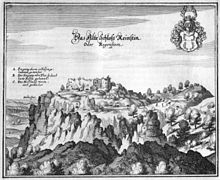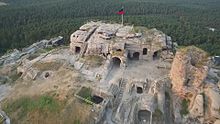Regenstein Castle
| Regenstein Castle | ||
|---|---|---|
|
Regenstein castle ruins from the south |
||
| Alternative name (s): | Reinstein | |
| Creation time : | 12th Century | |
| Castle type : | Höhenburg, rocky location | |
| Conservation status: | ruin | |
| Place: | Blankenburg (District of Harz) | |
| Geographical location | 51 ° 48 '55 " N , 10 ° 57' 35" E | |
| Height: | 289.4 m above sea level NHN | |
|
|
||

The castle Regenstein in the northern Harz foreland is the ruins of a medieval rock castle at Blankenburg in Saxony-Anhalt Harz district .
Only ruins remain of the castle complex from the high Middle Ages , which is difficult to take . Some of the rooms carved into the rock and the remains of the keep have been preserved . The ruins are surrounded by the remains of the modern fortress.
Geographical location
The castle ruins are located in the Harz / Saxony-Anhalt Nature Park , just under 3 km north of Blankenburg and around 3.5 km east-southeast of Heimburg on the sandstone cliffs of the Regenstein ( 293.9 m above sea level ), which rises steeply from the Harz foreland. On topographic maps is on the site of the former castle 289.4 m , a height measurement point listed. The Regensteinmühle was located below the ruins .
history
Castle of the Regenstein Counts
Conrad, the son of Count Poppo I von Blankenburg , was first mentioned in a document in 1162 as Comes de Regenstein ( Count von Regenstein ). The castle became famous above all through Count Albrecht II of Regenstein (1310-1349), who in the 1330s often had disputes with the rulers of the surrounding cities, the Bishop of Halberstadt and the Abbess of Quedlinburg . These stories were romantically transfigured in the ballad Der Raubgraf by Gottfried August Bürger (set to music by Johann Philipp Kirnberger ) and the novel Der Raubgraf by Julius Wolff .
In the 15th century, the Regenstein family of counts moved to Blankenburg Castle. The castle fell into disrepair and became a ruin. The last male descendant of the noble family, Count Johann Ernst von Regenstein, died in 1599.
After several changes of ownership, in 1643 Regenstein, which was sometimes spelled Rheinstein or Reinstein , was assigned as a fiefdom to the Lower Bavarian Count Wilhelm von Tattenbach by Archduke Leopold Wilhelm of Austria in his function as Bishop of Halberstadt . From then on, this noble family called itself "Count von Reinstein-Tattenbach". In 1671 Johann Erasmus Graf von Reinstein-Tattenbach was beheaded in Austria as a participant in the magnate conspiracy , in the course of which Elector Friedrich Wilhelm von Brandenburg confiscated the county.
Prussian fortress
The castle complex was expanded into a fortress from 1671 by the Prussians , who were also the last users of their military function . The original castle complex only takes up a small part of the area that has been converted. In 1677 the fortress became a garrison. In 1736 lightning struck the powder tower and severely damaged the fortress. The outer length of its enclosing wall was extended to 1,200 m by 1742. Even under the French, to whom the fortress had to be handed over on September 12, 1757, it was structurally expanded. The Prussians recaptured it just five months later, on February 12, 1758, and made the facility unusable. The powder store, which was relatively high up, was blown up. From this fortress only the casemates , the fixtures in the rock and the restored entrance gate remained. Characteristic are the many cave-like rooms carved into the rock, in which today there is an exhibition of soil finds from the castle area. Even the horse stables were carved into the rock. After 1758 the pastures and forests around the Regenstein came to the Prussian office of Westerhausen . After the Westphalian rule (1807–1813, Canton Halberstadt-Land), Regenstein belonged to the Halberstadt district as the smallest Prussian exclave from 1815–1945.
Johann Wolfgang von Goethe and the painter Georg Melchior Kraus visited the Regenstein on September 11, 1784 on his third trip to the Harz Mountains to conduct geological studies. In the Goethean rock collection, two drawings and a rock sample commemorate this visit.
Fountain
The castle fountain with a depth of 197 meters came from 1671 and thus from the early period of the fortress . This makes the structure top of the list of the deepest castle wells in the world.
“The water, which is praised as very cool, clear and tasty, was lifted up by means of a wheel in which three men were walking and whose shaft was 3½ feet in diameter. It took almost a quarter of an hour to wind up the bucket, which was fastened to a strong rope and which held 40 measures of water, and happened three times a day. Unfortunately, the well was also affected by the demolition and spilled to a depth of 400 feet. Since the visitors to the mountain took pleasure in throwing sand and stones into the shaft, its depth quickly decreased [...]. "
The well was completely buried in 1885 after the depth was only 62 feet in 1855 and masonry threatened to topple over.
The sagas of the Regenstein
One of the most beautiful virgins in the country was once held captive in the dungeon of Regenstein Castle because she disdained the love of Count von Regenstein. With a diamond ring, she scratched a crack in the rock, which after a year was so big that she could crawl through and escape. After her escape, she returned to the castle with her relatives, but the count had disappeared. A little later she noticed that thick smoke was oozing from a crack in a rock wall. When she looked through, she saw the count in purgatory. So out of pity she threw him her ring to calm the count's spirit.
tourism
The tourist use of the castle area began with the opening of the first restaurant in 1812. The castle ruins are a popular destination. Every year there is a knight's game and a garrison festival. It is included as No. 80 in the system of stamping points of the Harz hiking pin. Until 2015 there was a falconry on site , which moved to Güntersberge in the Lower Harz in the following year . The castle restaurant has been closed since spring 2017. Currently (May 2018) the restaurant is being completely renovated.
View from the Ziegenberg east-southeast over Heimburg to the Regenstein
literature
- Friedrich Gottschalck : The knight castles and mountain castles of Germany. Volume 3. 2nd, improved and enlarged edition. Hemmerde and Schwetschke, Halle 1820, p. 192 .
- Rudolf Steinhoff: The Regenstein . Brüggemann, Blankenburg 1883, p. 97 .
- Kaethe Woltereck: The Regenstein on the Harz. A German stronghold from prehistoric and historical times. With 16 pen drawings by W. Kranz. Carl Mittag, Gernrode undated (around 1925).
- Karl Bürger : The Regenstein near Blankenburg am Harz. Its history and description of its ruins . 4th, improved edition. E. Appelhans & Comp., Braunschweig 1931, p. 52 .
- Heinz Wedler, Erich Dülsner: The Regenstein castle ruins. A contribution to German history (= series of publications by the Society for the Dissemination of Scientific Knowledge. Series D: Social Sciences. 25/26). Urania-Verlag, Leipzig et al. 1957.
- Heinz A. Behrens : The Regenstein. Two volumes (Vol. 1: Settlement and history of the counts until 1500. Vol. 2: Building history and fortress times. ). Regenstein Castle and Fortress, Blankenburg 1989–1992.
Web links
- Brenda Effler: The Regenstein. GiBS.info, 2010, accessed on September 16, 2012 (report on the Regenstein). (Klio eV)
- Regenstein Castle in reconstruction drawings of German castles , on burgrebaus.de
- Description of the castle in the Braunschweig-Ostfalen region
- Regenstein castle and fortress ruins - private site about the complex
Individual evidence
- ↑ Map services of the Federal Agency for Nature Conservation ( information )
- ↑ Saxony-Anhalt viewer of the State Office for Surveying and Geoinformation ( notes )
- ↑ Cf. G. Ulrich Großmann : Ordinary and unusual ways of supplying water to castles. In: Hydraulic engineering in. Middle Ages and Modern Times (communications of the German Society for Archeology of the Middle Ages and the Modern Age 21). Paderborn 2009, pp. 181-188.
- ↑ Karl Bürger: The Regenstein near Blankenburg / Harz. Its history and description of its ruins . Osterwieck 1905, p. 56. Archived from the original ; accessed on January 19, 2018 .
- ^ Cf. Karl Bürger: The Regenstein near Blankenburg / Harz. Its history and description of its ruins . Osterwieck 1905, p. 56. Archived from the original ; accessed on January 19, 2018 .
- ↑ Harzer Wanderadel: Stamp 80 / Regenstein Castle Ruins , on harzer-wandernadel.de










